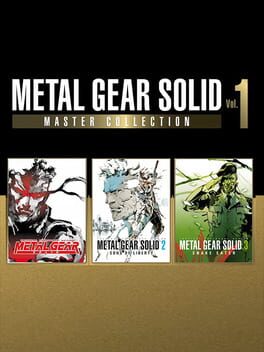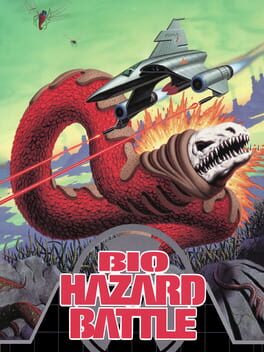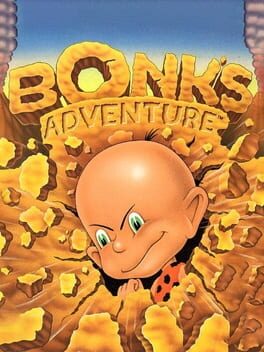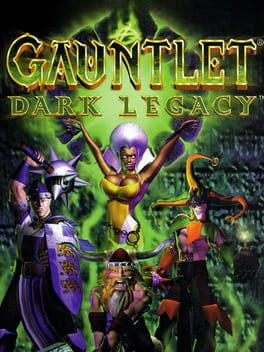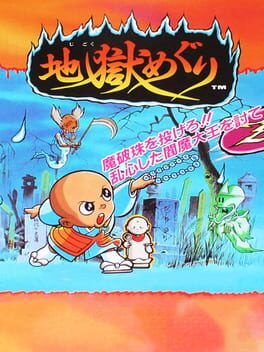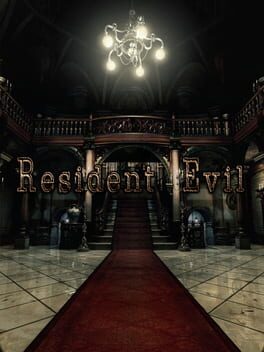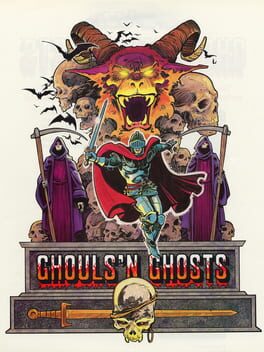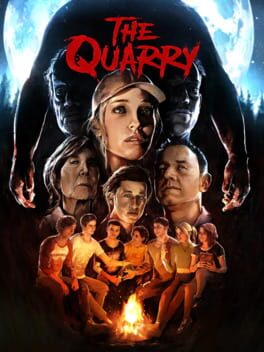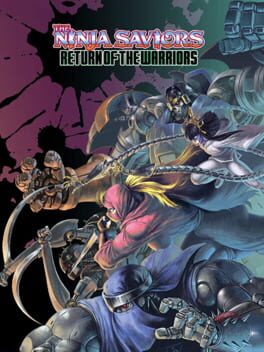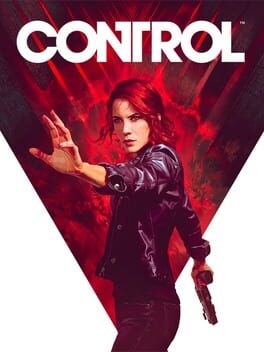ogremode
Replay, playing through as Richter. Goatvania. There's the idea that this is a "step back" from Super Castlevania IV since it doesn't have the free whip mechanic. I'm a Castlevania IV liker, but the free whip is almost entirely useless, as fun as it is, and it is fun (an invention of Treasure programmer Mitsuru Yaida). Richter's unique backflip though is fun AND cool looking AND on top of that it's useful—enemies and bosses are built around cleverly using your backflip. And the graphics and levels in Rondo whip every other classicvania's ass.
1992
Biohazard Battle is a simple, medium difficulty STG that excels in presentation. The game feels like it begins immediately. Its OST blares over the SEGA logo as soon as you turn it on, leading you seamlessly to its start menu. After selecting your ship, the game begins as its dropped from a large mothership and the player ship descends from space through the planet's atmosphere and then finally the horizontal shooting segment that takes up the rest of the game. The slow blending of the black space and the blue atmosphere effect, the crescendoing music, the transition from the logos to the menu to the game itself, all as the OST supports these images—it achieves a unique cinematic effect that I not only haven't seen in other shooting games, but in many games period, even those whose whole purpose is to blend cinema and gameplay.
The remaining game has a sense of cohesion and verisimilitude as you travel through various biomes and take down the bug themed enemies. Its a pretty good console horizontal shooter, with caveats. The power up system is somewhat limited—there are a few different colored pick-ups as usual, but there's no upgrade system you usually see in STGs, so it makes the gameplay feel samey even though the levels and enemies have unique and interesting designs. It's always fun though. What really sets it apart is its presentation and style, not its gameplay.
The remaining game has a sense of cohesion and verisimilitude as you travel through various biomes and take down the bug themed enemies. Its a pretty good console horizontal shooter, with caveats. The power up system is somewhat limited—there are a few different colored pick-ups as usual, but there's no upgrade system you usually see in STGs, so it makes the gameplay feel samey even though the levels and enemies have unique and interesting designs. It's always fun though. What really sets it apart is its presentation and style, not its gameplay.
1989
Bonk's Adventure is a very simple platforming game. Some other people remark that there isn't that much platforming to it, and that's true—you are mostly moving from left to right without much jumping or challenge. Don't play this game expecting Mario. The pleasure of Bonk's Adventure comes from its "game feel" — the way the cartoony animations tie so closely to your button presses. It's a great feeling game, even if it isn't a unique or interesting one in its level or enemy design.
Though I was honestly initially put off by the art and unholy character style, which is chibi-esque but vaguely Western animation inspired—which is to say, ugly. I ended up being really charmed by Bonk, and it all comes from little touches. The way Bonk peacefully lays on his back like he's in a coffin when he runs out of health, waiting for you to spend a credit to revive him, made me laugh every time. His maniacal Bart-ish transformation when he's biting a wall to hold onto it and climb it is hilarious, and the way he shakes slightly upward as you repeatedly tap the jump button, until he finally leaps into the sky—it feels excellent.
Bonk's unique feature is right there in his name. Like all of us, Bonk is what he does—and for Bonk, that's bonking. For purposes of this review, bonking refers to smashing paradoxically diamond hard yet infant shaped head against things. There's the standard Bonk attack, where, after a slight satisfying Castlevania-esque wind-up, Bonk moves forward with a headbutt. There's the up-bonk, where Bonk jumps from underneath something to headbutt it from below. Then there's the divebonk. Unlike Mario, Bonk will get hurt if he lands leg first on an enemy—rather, he must land headfirst. The dive bonk triggers from a jump, and travels forward in an arc, and landing it always feels great. Bonk gets a little bounce from a successful dive bonk, and it is little. You can chain your up bonks into dive bonks, and after landing a dive bonk, chain that into more dive bonks. You can also continously juggle enemies with your various Bonk attacks—dive bonking them to send them into the air, up bonking to bounce them again, and so on. Sometimes juggling enemies will spawn a meat, which Bonk's power up. When you eat a small meat, Bonk's skin gets darker (?) and he can freeze enemies by dive bonking on the ground around them. Eating a large meat, or two small meats, will cause Bonk's skin to grow even darker, (?) and he will enjoy a brief period of invincibility.
The enemies are mostly no great shakes, though my favorite were the Bonk-like dinosaurs that have your same moveset; I love these kinds of fights in Dark Souls games and Zelda games, and they were just as fun here. There are some other interesting ideas, like the flowers that usually spawn point giving fruit sometimes turning into an enemy when jumped on. Where Bonk shines as a game is in its boss fights, where you will be searching for the perfect dive-bonk opportunities to whittle down your enemies health. These are built around giving you opportunities for dive-bonk combos, and pulling them off always felt good. There's a boss rush at the end of the game, and it was fun to fight them all again after having more bonking experience under my belt.
I'm looking forward to playing more Bonk. I love the feel of Bonk, but I don't think this first game really uses him or its ideas to their full potential. I hope they develop them in later games.
Though I was honestly initially put off by the art and unholy character style, which is chibi-esque but vaguely Western animation inspired—which is to say, ugly. I ended up being really charmed by Bonk, and it all comes from little touches. The way Bonk peacefully lays on his back like he's in a coffin when he runs out of health, waiting for you to spend a credit to revive him, made me laugh every time. His maniacal Bart-ish transformation when he's biting a wall to hold onto it and climb it is hilarious, and the way he shakes slightly upward as you repeatedly tap the jump button, until he finally leaps into the sky—it feels excellent.
Bonk's unique feature is right there in his name. Like all of us, Bonk is what he does—and for Bonk, that's bonking. For purposes of this review, bonking refers to smashing paradoxically diamond hard yet infant shaped head against things. There's the standard Bonk attack, where, after a slight satisfying Castlevania-esque wind-up, Bonk moves forward with a headbutt. There's the up-bonk, where Bonk jumps from underneath something to headbutt it from below. Then there's the divebonk. Unlike Mario, Bonk will get hurt if he lands leg first on an enemy—rather, he must land headfirst. The dive bonk triggers from a jump, and travels forward in an arc, and landing it always feels great. Bonk gets a little bounce from a successful dive bonk, and it is little. You can chain your up bonks into dive bonks, and after landing a dive bonk, chain that into more dive bonks. You can also continously juggle enemies with your various Bonk attacks—dive bonking them to send them into the air, up bonking to bounce them again, and so on. Sometimes juggling enemies will spawn a meat, which Bonk's power up. When you eat a small meat, Bonk's skin gets darker (?) and he can freeze enemies by dive bonking on the ground around them. Eating a large meat, or two small meats, will cause Bonk's skin to grow even darker, (?) and he will enjoy a brief period of invincibility.
The enemies are mostly no great shakes, though my favorite were the Bonk-like dinosaurs that have your same moveset; I love these kinds of fights in Dark Souls games and Zelda games, and they were just as fun here. There are some other interesting ideas, like the flowers that usually spawn point giving fruit sometimes turning into an enemy when jumped on. Where Bonk shines as a game is in its boss fights, where you will be searching for the perfect dive-bonk opportunities to whittle down your enemies health. These are built around giving you opportunities for dive-bonk combos, and pulling them off always felt good. There's a boss rush at the end of the game, and it was fun to fight them all again after having more bonking experience under my belt.
I'm looking forward to playing more Bonk. I love the feel of Bonk, but I don't think this first game really uses him or its ideas to their full potential. I hope they develop them in later games.
2000
I played through Gauntlet: Dark Legacy in co-op with a friend and had a lot of fun. Gauntlet is an arcade top-down shooting game with a few extra mechanics—bump attacks, heavy melee attacks, blocking, special moves, and a variety of item power ups—on top of this there is a leveling up and gold system, which can be used to buy items or stat upgrades. There are a number of character classes, and each one has a different set of starting stats—the knight is slower but more powerful, the wizard has stronger magic attacks, the jester, who I chose, is faster but starts weaker. As you level up your character across the game, each character becomes more and more like the other. Since you can buy stat upgrades—which I did almost every chance I got, in leuie of buying health items between mission—you have some say in how your character develops. By the late 70s or early 80s level, my jester had their speed and strength all the way maxed out.
The game is pretty economical. There are different enemy models for each world, but there are only a few different character classes that have more damaging tiers—rushing enemies that blow up, long range enemies, short range melee enemies, commander style enemies, and small type enemies that can be overwhelming in large numbers. Then there are unique minibosses like golems, grim reapers, and dragons that take and do more damage than the usual enemies.
The basic loop is working your way through a series of themed levels finding collectibles and keys. You unlock different worlds through finding colored stones, and can move between worlds at any time from the hub area. Each world will have a special item in it that will do major damage to the boss of another world, so you're incentivized to explore the available worlds before taking on the each world's bosses. My favorite levels were the jester levels, which are all fantastical and dreamlike, EC Escher inspired. I also liked the Doom-inspired flesh-wall/blood level.
The game is mindless fun, but I wish there was just one more layer of something to it. What I really felt was missing was a way to avoid damage. Taking damage in regular levels is usually pretty harmless, but since boss fights have a ton of moves you can't dodge, they mostly feel like rote HP checks—can you dish out enough damage before dying? Usually, you can. But I would have liked a dodge roll or a stronger block move or something like that, which could have made the boss fights feel a little more active.
I had a good time playing through this—it took about 11 hours. It made me curious about the earlier Gauntlet games.
The game is pretty economical. There are different enemy models for each world, but there are only a few different character classes that have more damaging tiers—rushing enemies that blow up, long range enemies, short range melee enemies, commander style enemies, and small type enemies that can be overwhelming in large numbers. Then there are unique minibosses like golems, grim reapers, and dragons that take and do more damage than the usual enemies.
The basic loop is working your way through a series of themed levels finding collectibles and keys. You unlock different worlds through finding colored stones, and can move between worlds at any time from the hub area. Each world will have a special item in it that will do major damage to the boss of another world, so you're incentivized to explore the available worlds before taking on the each world's bosses. My favorite levels were the jester levels, which are all fantastical and dreamlike, EC Escher inspired. I also liked the Doom-inspired flesh-wall/blood level.
The game is mindless fun, but I wish there was just one more layer of something to it. What I really felt was missing was a way to avoid damage. Taking damage in regular levels is usually pretty harmless, but since boss fights have a ton of moves you can't dodge, they mostly feel like rote HP checks—can you dish out enough damage before dying? Usually, you can. But I would have liked a dodge roll or a stronger block move or something like that, which could have made the boss fights feel a little more active.
I had a good time playing through this—it took about 11 hours. It made me curious about the earlier Gauntlet games.
1990
I put this one on because the screenshot made it look like a Taito rip off of Ghosts n Goblins—and it basically is, with the difficulty and speed turned all the way down. Where Ghosts n Goblins can be frustratingly difficult, this is a frustratingly boring game. Despite dying in one hit, the platforming is wildly easy, and the enemies are pretty easy to avoid. I got to a boss in the third stage, which fired a spread pattern that was kind of fun to dodge. But I wasn't compelled to continue.
1993
Night Slashers is Data East's horror themed BTM game (beat em up) about three 90s OVA characters—an edgy blonde white guy with robot arms, a martial artist vampire hunter, and a highly agile female martial artist—killing zombies, Frankenstein, Frankenstein's monster, werewolves, vampires, Dracula himself, Final Fight enemies with axes, fat guys, mummies, commando knife fighters with and without Jason masks. Like most BTMs, how much you enjoy the game is going to mostly rely on how much you vibe with the theme. There's a lot of variety in enemies and level art, but the level designs still feel somewhat samey. The combat is simple BTM stuff, but there's a little bit of complexity in special moves and grabs. The bosses are pretty easy, but their standard trick is that they spawn adds. The best part of this game is the animation, which can be really satisfying, particularly the death animations. Zombies (and weirdly other enemies) melting into nasty piles of goo after death never got old.
2014
Tapping out after a few hours. I'm afraid I'm not having fun. Maybe I'll return to this later and click with it, but backtracking is frustrating for me and that's basically the entire game. I'm left wanting some sense of forward momentum. A cool setting and great art, undeniably influential and loved by many—but maybe this genre just isn't for me. I can't figure out how to suplex zombies
Hagane is a side-scrolling action game developed by CAProductions, who probably most notably also developed the Saturn mecha game Bulk Slash, and now primarily work on the Mario Party series. This lineage seems odd at first glance, but on reflection makes a lot of sense. Hagane is brimming with ideas. There are five stages. Each stage is broken into different sub-stages—1-1, 1-2, and so on, ending with a boss battle. And each of these brief sequences is typically a succinct exploration into a particular idea or mechanic—in the same spiritual sense as Mario Party minigames, but tied beautifully together in a side-scrolling action game package. Some of these ideas are based in the level itself, like autoscrolling horizontal or vertical platforming sections, or working your way through a labyrinth where doors warp you to surprising places, or bursting through a level by destroying walls, or exploring a cave system to find the boss, or the STG-like autoscrolling level where Hagane drives a floating bike (?) through the Mode 7-powered warbling environment of a crashing space ship; some of the levels force you to use a certain move that Hagane can do to move through the level efficiently. And Hagane can do a lot of moves.
At its core, Hagane is a Shinobi-style action game, but there's a surprising amount of depth to your movement and attack options. Hagane, like a Rolling Thunder character, can walk left and right and duck. He can jump and vertically down kick onto enemies heads like Mario, bouncing off them. He can ground slide like Mega Man, and there is a Mega Man 4 Square Machine-style boss that requires sliding. With the respective shoulder buttons, he can somersault left or right, which speeds up movement and can dodge attacks. Holding down the somersault button will have Hagane somersault a second and third time, going higher and changing colors each time, indicating that a different special move can be done—a forward sliding ground attack on the first somersault, an upwards flipping jump kick at the second, and an area of effect attack at the third. When the attack button is pressed during a jump to the left or right, Hagane will do a side kick. When the jump button is pressed again just under the apex of Hagane's jump, Hagane will roll forward horizontally; there is an autoscrolling level where you have to use this exactly. When you roll horizontally into a wall, Hagane will bounce off; by continuing to hold down the jump button he will ping pong back and forth between the walls, traveling upward. Hagane can hang onto ceilings and moving platforms by jumping from underneath them and pressing the up button at the bottom surface; there's a level entirely based around this mechanic, at least if you want to make it through without taking too much damage. And there's a special move Hagane can trigger at any time, if he has ammo for it, that does damage to all enemies on screen and makes Hagane briefly invincible.
Hagane has multiple weapons, but he can only equip one of them at a time; you have a button to cycle through these. Most of them use ammo that drop from enemies, but I rarely found that I was out of ammo for any particular weapon. There's the short range, fast katana, that will be your bread and butter; there are grenades that Hagane throws in a short arc; there are long range, fast kunai; then finally there's a slightly slower, slightly shorter range grappling hook, that Hagane can also throw at ceiling surfaces to pull himself towards them while jumping.
This tendency of multiple possibilities extend to certain enemies as well, like the floating house robots that can, and sometimes must be, used as platforms. Most bosses are puzzle bosses that require one or two of these mechanics, and using a certain weapon or two to capitalize on openings.
The sheer amount of things you can do, and the levels being typically so different from each other, reminds me a lot of another one of my favorite side-scrolling action games—Gunstar Heroes. And like with that game, it can feel like these developers only got to scratch at the surface of possibilities. A Hagane playthrough is only half an hour, but on the bright side, it never feels stale. The character and enemy art designs are all by the legendary tokusatsu film director Keita Amemiya, who is in his Zëiram era, which mixes traditional Japanese theatre images with nasty, quasi-biological robot designs. This works well for a video game because he likes sticking little spooky faces on everything—so you know where you need to hit them. Amemiya's involvement is what got me to play this game in the first place. I was really happy to find such a rich, cool action game.
At its core, Hagane is a Shinobi-style action game, but there's a surprising amount of depth to your movement and attack options. Hagane, like a Rolling Thunder character, can walk left and right and duck. He can jump and vertically down kick onto enemies heads like Mario, bouncing off them. He can ground slide like Mega Man, and there is a Mega Man 4 Square Machine-style boss that requires sliding. With the respective shoulder buttons, he can somersault left or right, which speeds up movement and can dodge attacks. Holding down the somersault button will have Hagane somersault a second and third time, going higher and changing colors each time, indicating that a different special move can be done—a forward sliding ground attack on the first somersault, an upwards flipping jump kick at the second, and an area of effect attack at the third. When the attack button is pressed during a jump to the left or right, Hagane will do a side kick. When the jump button is pressed again just under the apex of Hagane's jump, Hagane will roll forward horizontally; there is an autoscrolling level where you have to use this exactly. When you roll horizontally into a wall, Hagane will bounce off; by continuing to hold down the jump button he will ping pong back and forth between the walls, traveling upward. Hagane can hang onto ceilings and moving platforms by jumping from underneath them and pressing the up button at the bottom surface; there's a level entirely based around this mechanic, at least if you want to make it through without taking too much damage. And there's a special move Hagane can trigger at any time, if he has ammo for it, that does damage to all enemies on screen and makes Hagane briefly invincible.
Hagane has multiple weapons, but he can only equip one of them at a time; you have a button to cycle through these. Most of them use ammo that drop from enemies, but I rarely found that I was out of ammo for any particular weapon. There's the short range, fast katana, that will be your bread and butter; there are grenades that Hagane throws in a short arc; there are long range, fast kunai; then finally there's a slightly slower, slightly shorter range grappling hook, that Hagane can also throw at ceiling surfaces to pull himself towards them while jumping.
This tendency of multiple possibilities extend to certain enemies as well, like the floating house robots that can, and sometimes must be, used as platforms. Most bosses are puzzle bosses that require one or two of these mechanics, and using a certain weapon or two to capitalize on openings.
The sheer amount of things you can do, and the levels being typically so different from each other, reminds me a lot of another one of my favorite side-scrolling action games—Gunstar Heroes. And like with that game, it can feel like these developers only got to scratch at the surface of possibilities. A Hagane playthrough is only half an hour, but on the bright side, it never feels stale. The character and enemy art designs are all by the legendary tokusatsu film director Keita Amemiya, who is in his Zëiram era, which mixes traditional Japanese theatre images with nasty, quasi-biological robot designs. This works well for a video game because he likes sticking little spooky faces on everything—so you know where you need to hit them. Amemiya's involvement is what got me to play this game in the first place. I was really happy to find such a rich, cool action game.
1988
A much more playable update of Ghosts n' Goblins—I actually played through an entire loop before putting it down this time, and only didn't continue because putting the final boss behind an entire second loop is just insulting. Still quite difficult since you can really put yourself in an unwinnable corner; the second to last boss (my final boss) feels especially cheap. But I had a lot more fun this time. There's just a little bit more variety in everything—levels, weapons, enemies, bosses.
1985
2022
I played through Supermassive Games's cinematic horror game The Quarry with my wife. We picked our characters at the start and passed the controller back and forth throughout. It was a pretty fun experience. The game is primarily "cinematic" gameplay like QTE sequences, and long cut scenes where you may make a choice or two for dialogue or the action your character takes. To break these up, there's also exploration sequences, where you can guide your character around surprisingly large spaces, though often these spaces are pretty empty. The last mode of gameplay is brief third-person shooting segments. My wife isn't a non-gamer, but she's not used to third person shooting, and she ended up fumbling at a crucial moment that led to a character's death—it was one of those rare moments of failure driven ludonarrative consonance. It really made me laugh.
Definitely a good time for a few people who like shitty teen horror movies. I do wish the option to rewind was available from the start. I'm not really interested in replaying whole sections, especially after finding out the epilogue sequence just lists who lived and who died.
Definitely a good time for a few people who like shitty teen horror movies. I do wish the option to rewind was available from the start. I'm not really interested in replaying whole sections, especially after finding out the epilogue sequence just lists who lived and who died.
I had a blast playing through Tengo Project's Ninja Saviors. I ran through the game mostly as Ninja, a hulking cyborg-ninja with glowing red eyes and huge metal arms. It felt like I was playing through one of those ultraviolent 90s OVAs, and I was playing as the bad guy. Like all beat em ups, there's not very much difficulty here outside of the bosses, and even the majority of those are chumps; unlike most beat em ups, the minute to minute gameplay is really fun and interesting. The different action buttons all change depending on the direction you're holding, and the context—whether you're holding an enemy, on the ground, in the air, dashing, etc. There's a ton of depth to the beating them upping, and getting a handle on your character is really rewarding. My only real complaint is that a few bosses can feel cheap, and that it's just a smidge too long for me to run through on a whim. Looking forward to dipping back into this one and playing with the other characters.
2019
Dipped back into Control to do the Wake DLC, after putting it down in February 2021. Without realizing it, I only had two missions/levels left in the game to go, so I finished them as well. Like in replaying Alan Wake, I kind of got tired of the sheer number of fights, but there's so much more here to play around with. The fights are a lot of fun but it feels like they can turn in the enemies favor frustratingly quickly, and I found myself repeating fights an annoying number of times. Granted, I returned to endgame content after two years of not playing it at all, so maybe I'm playing it wrong, or I've invested my ability points wrong, but Jesse is such a squishy character, as powerful as she is. Still I had a good enough time that after finishing it I wanted to start the game on a current gen version. I finished the PS4 version, which looked good and played well enough on my PS5; I did encounter one annoying bug which is that button prompts, or half of them, would randomly stayed glued to the screen until they disappeared just as randomly. If there's a way to move the last gen saves to the upgraded version, I could not find it. The action is very strong and a lot of fun, and the game essentially has infinite content if you want to keep plugging away at it. What's most attractive to me about this game is its vibe and characters, and it was really fun to see Jesse interact in the usual dreamlike way with Alan Wake. Really looking forward to AW2 later this month.
2021
I played the original on 360 when it came out and remembering liking it a lot; I even snaked an ethernet cable into my childhood bedroom so I could buy and download the DLC. I dipped back into Alan Wake to remind myself what it felt like, and to refresh myself on the characters and story before the sequel releases later this month. I had somewhat of a good time playing through the first three chapters; I love the vibe and mood. But I'm not going to finish my playthrough.
Alan Wake is a horror themed Zelda like. Each chapter is made up of sequences of exploration, action, and puzzle solving, broken up by infrequent cut scenes. There are two modes of exploration sequences--at the beginning of chapters there are safe locations to look around in, talk to characters, and explore the space. After a cut scene, the rest of a chapter follows Alan Wake moving from location A to B. In between enemy encounters, you explore dark, spooky places looking for resources (ammunition, flares, weapons, and collectibles). There may be puzzles to solve in your traversal, but most of the game is made up of its action segments.
The shooting feels good, but there's not very much to it. You shine a flashlight on a guy while he ambles towards you, popping his shield right before he gets within melee range, then blowing him away just in time in close quarters pistol combat like you're John Wick via James Sunderland. Letting an enemy get close to you right before stunning them always felt really fun to pull off. For groups of enemies you have to do a little crowd control and herding, so you can get multiple enemies in your light beam or more typically blow them all up at once with the flashbang or flaregun.
There are fun fights, but for every encounter with an interesting arena, or with lamps you can activate as traps or barrels to explode, there are five dull encounters where you have to fight a bunch of guys in the woods, which looks and feels exactly the same throughout the game. These woods fights feel compulsory, like the player might get bored from just wandering around in the dark--could they be vestiges of Alan Wake's original open world concept? Either way, like random counters in JRPGs, they are not usually very fun, and happen constantly. Maybe these encounters are meant to whittle down your ammunition like a survival horror game, but I never once was really low on anything, and I rarely found myself even close to running out of ammo for a particular weapon, and I wasn't particularly frugal about using my weapons either.
Due to the limited action, and the frequency and lack of variety in encounters, I found myself unfortunately pretty bored for a lot of my time with the game. I wanted to get to the next interesting part, and it meant wading through a bunch of bullshit to get there. I'm hoping to finish the Control Wake DLC before Alan Wake 2 comes out, and I wouldn't have had time to finish this game as well, so I decided to go ahead and drop the game after the start of the fourth chapter. I'm disappointed to say that putting the game down was easy.
Alan Wake is a horror themed Zelda like. Each chapter is made up of sequences of exploration, action, and puzzle solving, broken up by infrequent cut scenes. There are two modes of exploration sequences--at the beginning of chapters there are safe locations to look around in, talk to characters, and explore the space. After a cut scene, the rest of a chapter follows Alan Wake moving from location A to B. In between enemy encounters, you explore dark, spooky places looking for resources (ammunition, flares, weapons, and collectibles). There may be puzzles to solve in your traversal, but most of the game is made up of its action segments.
The shooting feels good, but there's not very much to it. You shine a flashlight on a guy while he ambles towards you, popping his shield right before he gets within melee range, then blowing him away just in time in close quarters pistol combat like you're John Wick via James Sunderland. Letting an enemy get close to you right before stunning them always felt really fun to pull off. For groups of enemies you have to do a little crowd control and herding, so you can get multiple enemies in your light beam or more typically blow them all up at once with the flashbang or flaregun.
There are fun fights, but for every encounter with an interesting arena, or with lamps you can activate as traps or barrels to explode, there are five dull encounters where you have to fight a bunch of guys in the woods, which looks and feels exactly the same throughout the game. These woods fights feel compulsory, like the player might get bored from just wandering around in the dark--could they be vestiges of Alan Wake's original open world concept? Either way, like random counters in JRPGs, they are not usually very fun, and happen constantly. Maybe these encounters are meant to whittle down your ammunition like a survival horror game, but I never once was really low on anything, and I rarely found myself even close to running out of ammo for a particular weapon, and I wasn't particularly frugal about using my weapons either.
Due to the limited action, and the frequency and lack of variety in encounters, I found myself unfortunately pretty bored for a lot of my time with the game. I wanted to get to the next interesting part, and it meant wading through a bunch of bullshit to get there. I'm hoping to finish the Control Wake DLC before Alan Wake 2 comes out, and I wouldn't have had time to finish this game as well, so I decided to go ahead and drop the game after the start of the fourth chapter. I'm disappointed to say that putting the game down was easy.

